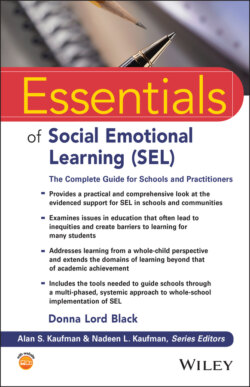Читать книгу Essentials of Social Emotional Learning (SEL) - Donna Lord Black - Страница 38
Rapid Reference 1.5 Texas School‐Based Social/Emotional Wellness Model
ОглавлениеA description of the social‐emotional wellness model developed by the Texas Collaborative for Emotional Development in Schools (TxCEDS) was printed by the Region 4 Education Service Center in Houston, Texas, and was disseminated to the 20 education service centers throughout Texas in October 2010 (Texas Education Agency and Region 4 Education Service Center, 2010 ). The document describing the model was entitled “Social‐Emotional Wellness in Texas Schools: A Guide for Schools, Agencies, Organizations, Parents, and Communities.” A summary of the model is provided as follows.
The Texas School‐Based Social/Emotional Wellness Model was designed as a comprehensive service delivery model to promote collaborative and coordinated approaches for addressing whole student needs through a multitiered process. Improvements in student, system, and school outcomes, as well as improvements in the model itself, are informed by an ongoing and systematic review of data collected from five critical components of the model. Each of these components works in tandem with one another to ensure effectiveness and improve outcomes. The five components are:
1 Fundamental concepts
2 School‐based service delivery model
3 Student outcomes
4 System outcomes
5 Continuous improvement process
The foundation of the model is based on two fundamental concepts, psychological and educational principles. Knowledge and understanding of these principles are considered necessary for facilitating the delivery of scientific, evidence‐based practices in service delivery. To ensure understanding of these concepts, the model promotes the development and maintenance of high professional standards through ongoing professional development, increased awareness of mental health issues, and recognition of the diverse backgrounds and needs of students.
The school‐based service delivery process is the central focus of the Texas model. It is promoted as a whole‐child approach designed to address barriers to student learning and performance by connecting services within and between schools and communities. Interventions for struggling students are identified through the school’s systematic, problem‐solving process, and, if outside support services are available, they are coordinated through collaborative partnerships with agencies and organizations within the surrounding community. Through increased access to resources and supports, schools are better able to eliminate some of the barriers to student learning and performance for struggling students. Collaborative partnerships with which a school might coordinate additional supports and services may include early childhood intervention programs, private practitioners, faith‐based community supports, behavioral health agencies, public health agencies, juvenile justice, children and families, children’s protective services, and recreational programs, among others.
Contrary to the traditional model of service delivery, where interventions are targeted for separate and distinct problems (e.g., failing grades, poor attendance, substance abuse, bullying, delinquency, violence, etc.), this model offers a comprehensive, whole‐child approach to the problem‐solving process. Using interconnected systems, collaborative partnerships, and systematic review processes, barriers can be identified, and interventions can be developed to address the breadth and depth of any student’s needs.
Implementation of the comprehensive school‐based service delivery process ultimately leads to improved student outcomes, as well as improved system outcomes, which are two critical components of the Texas model. When student performance improves, so does system performance. Furthermore, when systems at all levels (i.e., educational systems, social services systems, community systems, family systems, etc.) share responsibility for students’ social and emotional wellness, improved outcomes for students might be seen in the following areas:
Academic achievement
Discipline and behavior
Social relationships
School attendance
Community involvement and civic responsibility
Graduation and postsecondary enrollment
When schools experience improved outcomes for their students, they are more likely to increase their operational capacity as well, thus leading to improved system outcomes. While system outcomes might include better ratings on accountability measures, these aren’t the only improvements that might result. Safer and more supportive learning environments promoted through this model also can lead to increased involvement from parents and community members with expanded opportunities for a continuum of school–community programs and services. With these opportunities, schools can further increase their capacity for serving their students.
The fifth component of the Texas model is the continuous improvement process that includes periodic and comprehensive annual reviews involving reflection; input from all stakeholders; a systematic collection, review, and analysis of data; and decision‐making procedures. Outcomes, results, and recommended improvements are reported annually to stakeholders.
The committee also developed a complete training program and a guidance manual to assist schools, parents, agencies, organizations, and community members with implementing the model through a school‐ or district‐wide approach to social and emotional wellness (in October 2010). The training was disseminated to all 20 education service centers in Texas, with the goal being broad dissemination to all schools throughout the 20 regions in the state.
As the project was finalized, the group credited the three‐step process, which was implemented at the project’s inception, with the ultimate success for the project. Without this process, they acknowledged they likely would have continued “to admire the problem,” thus wasting valuable time and resources.
